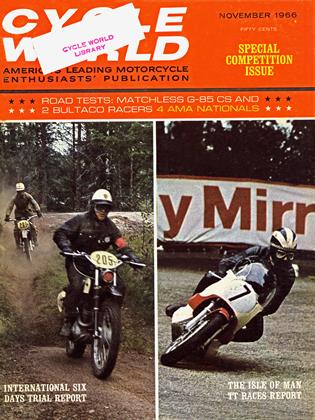JACK PINE NATIONAL ENDURO
BEFORE YOU RUN the 500-mile National Jack Pine Enduro, they give you a cow bell.
Some riders leaving the start at Lansing, Mich., wished they had brought theirs in tow, so they could ring for help before they sank to their ears in mud.
At 5:30 a.m. on a damp, overcast Sunday morning, the first of 576 riders left Lansing. Destination was the little town of West Branch, 115 air miles away, or 250 enduro miles. In every rider’s mind was the same thought: would the run go up Spring Hill as it did last year, wiping half the riders out? Or would it be the swamp that took a heavy toll of the 1964 entry.
Fortunately, the pathfinders and the weather had cooperated and there were no repeats of those years’ early wipe-outs.
But this year’s Jack Pine was no cinch. It could never be easy, for it winds through roller-coaster terrain that prompted one rider to say: “Man, this is God’s country. No one else would want it!”
The first of the bad spots was the Grand River, where a few drownings (of the mechanical type) occurred. Another one was Beaver Dam, to which spectators had apparently been clued in, for there were so many people jamming the banks of this mud hole that it was difficult for a rider to exit without hitting someone in the audience.
While things stayed relatively dry the first day, these and other hazards cut the field, so that only 346 reached the halfway point. Of these, only 318 decided to, or were able to begin the second day.
The favorites to win at this point were
John Penton, who had already won this event two times; Bill Baird, No. 1 enduro rider in the previous season; and Lansing native Joe Charlie. All three were keeping a tight reign on their schedules.
But as it began to rain shortly after the start of the return run south to Lansing, Penton, riding with an early number, may have had an advantage over Baird and Charlie, who were running later “flights” and therefore would encounter difficulties on terrain which had been thoroughly chewed up by hundreds of earlier riders. The route became very greasy and many riders needed assistance negotiating a stretch after the noon gas stop at Sanford, where the mud was deep enough to bury both rider and machine.
Two big heartbreakers for riders who had been running well on time the second leg were “Block and Tackle Hill” and "Fiddler’s Elbow.”
PERRY FIELDS
The hill was almost unclimbable and most riders detoured around it. Some properly came out on top to arrive at a check 200 yards later. Others went too far around the hill and came into the check backwards, which disqualified them.
The elbow and Check 18 came at the bottom of the hill. If the directional arrows weren’t followed in strict fashion on the way to this check, the rider would miss an extra observation check. Many found this section difficult and failed to do just that, thus being disqualified.
At the end of the second day, there were only 277 finishers of the original 576 who began.
John Penton, riding a Swedish-made Husqvarna, emerged the hair-breadth
Grand Champion of the Jack Pine with 987 points out of the possible 1,000. Only two points down was Bill Baird, Triumph, who was thus Class A Champion. Joe Charlie had dropped out of contention, but his 979 points were enough to bring him the Light Mediumweight crown. Scoring third overall and winning the Lightweight title was Bultaco-mounted Lester Peckham of Dewitt, Mich., with 982 points.
A pleasant bonus for Jack Pine riders was the support of the American Sports Co., which gave away a total of $1,100 in prizes and gift certificates. ASC, the makers of Fury helmets, plan to continue the practice annually.










